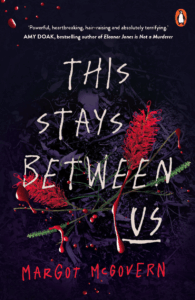Margot McGovern, This Stays Between Us, Penguin, April 2025, 327 pp., RRP $19.99 (pbk), ISBN 9781761346286
This book comes with a warning: “This book contains mature themes, violence, explicit scenes and point-of-view depictions of trauma and psychological distress. Reader discretion is advised.”
This warning is certainly appropriate.
A group of high school students go on a camp to an isolated spot – a spot where others have been before and which has a reputation for being ‘haunted’ and dangerous. The cabins they are to sleep in are all quite far apart so there are no immediate neighbours to call on if anything should go wrong. To make matters worse, there are only two teachers with them and, when one of the teachers has to take an injured student away for medical attention, only one is left.
This isolated setting is a necessary plot device allowing all the odd (and even dangerous) incidents to happen. The mysterious atmosphere and the ‘spookiness’ of the abandoned buildings on the site means that the fear and anticipation of something bad happening can be built up. Is Smiling Jack, who is reputed to haunt the place, real? Is the menacing figure some of the girls see really him? Who is it that leaves a single flower on each of the girls’ pillows? Who is it who stands just out of the light when the girls are round the fire? Is someone stalking them?
There is mistrust that builds up amongst the four girls in the most isolated cabin, mainly because three long-term friends are joined by a new girl, an outsider who seems to have problems of her own. Could she be the one doing the things that begin to frighten them all? The buildup of fear becomes almost palpable. There are film allusions throughout too that reference horror movies – one scene in particular when one of the girls senses there is someone in the bathroom behind the shower screen when she is supposed to be alone in the house, references Psycho.
Despite warnings from the teacher, the students drink – often too much – and this has dire consequences for one of the girls. An explicit sex scene describes what is really a rape as she is unconscious from drinking and her boyfriend has sex with her anyway. We learn later that the new girl – Shelley – has also been raped. Adolescent male behaviour is explored too. Of course, not all boys behave as these two do but the book does critique the lack of any kind of remorse or understanding from her boyfriend of Priya’s reaction to their sexual encounter. He feels that ‘all’s good’.
Smiling Jack is real, and the final meeting is terrifying. Is there something supernatural happening here? The girls themselves deal with the aftermath and resolve, as the title suggests, that they will keep this to themselves. All the girls are strongly drawn characters and the book explores friendship and female solidarity. Friendships and relationships can and do change and develop in unexpected ways and one of these is explored in a sub-plot of a lesbian romance.
The book is set out in alternating chapters with different points of view with one of the girls as the featured character for that section but in each the omniscient narrator remains.
This is a powerful and somewhat disturbing book that raises many questions about the issues that concern young people of sexuality, friendship, loyalty, social norms, social media, mental health and respectful relationships.
Reviewed by Margot Hillel





